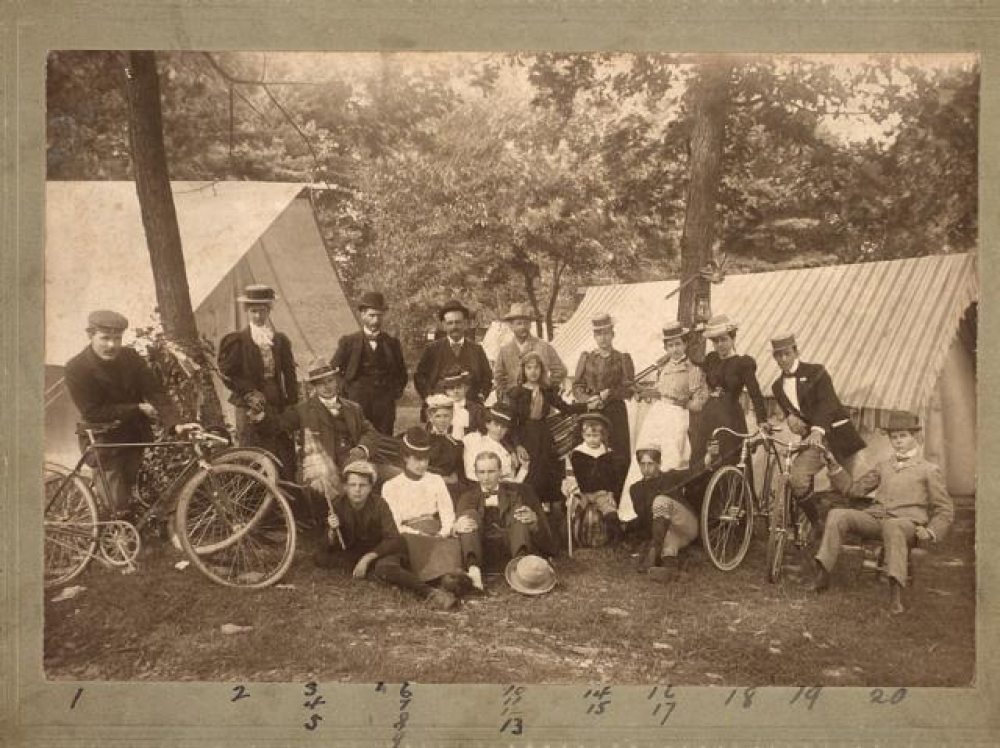While not entirely present in this photograph, according to the by-laws of the same year, the club’s uniform consisted of a “Peaked Cap, Tunic, Knickerbockers, and Ribbed Stockings all of a Dark Blue Color. [with] the trimmings to be of Black Braid…”
The bicycle, in its various forms, became an established form of amusement in the 1860s. [[1]] It was however, not until the late 1890s, that the bicycle craze was in full swing. It was during this time that the bicycle became the site of much public discussion. For Ottawa, the craze had taken hold by April of 1895, with The Ottawa Journal declaring the Capital, “all hot for wheels.” [[2]] In the same year, according to the Ottawa business directory, a concentration of bicycle shops could be found on Bank and Sparks Streets, six on Sparks and two on Bank. [[3]] One of these shops was McFarlane Bros, located at 115 Bank Street, it was originally an iron foundry that took up bicycle manufacturing during this period.
This bicycle boom reflects Victorian ideals and preoccupations, namely that of health and respectability. At a time when there was a growing concern over cities being unhealthy spaces, bicycling was seen as the right kind of sport for the health of the nation, as it benefited both physical and moral health. Regarding morality, the perspective at the time concerning morality and sport, viewed amateur sports as pure, reflecting respectability, while professional sports, where money was earned, as corrupt. In examining the Ottawa Bicycle Club (established in 1882), this attitude regarding the bicycle comes into view, as the clubs’ mandate which stated that the club was only open to amateurs.
The stated objective of the Ottawa Bicycle Club, according to the by-laws from 1890, was “to promote the general interest of cycling and to encourage and facilitate “touring.’” [[4]] By the last decade of the 19 th century, there was a growing concern for the proper use of bicycles in public spaces in an era of the ‘safe bicycle.’ This era meant, not only changes to the bicycle itself but concerns for the activity of cycling. The club, and other clubs like it, engaged in family-oriented bicycling, whereby rowdy, reckless cycling (read masculine qualities) was viewed as improper. Before this, during the highwheeler (a bicycle with a large front wheel and a small back one) phase, clubs operated on a more informal basis. Members would engage in Victorian chivalry, taking on the role of ‘two-wheeled knights.’ [[5]] In highlighting ‘touring,’ the mandate of the Ottawa Bicycle Club heeded this concern for proper bicycling etiquette. Etiquette was reflected in the respectability of the club members and through maintaining proper order in public spaces. The activity of touring indicates a level of activity that was seen as being beneficial to one’s physical health while maintaining respectability.
Maintaining one’s respectability was especially important for women who, with the development of the safe bicycle, took up cycling. Admittance of women into the club likely occurred around the time that the above photograph was taken, as between 1890-1891 greater numbers of women actively took up cycling in Canada. By the late 1890s, women accounted for between one-quarter and one-third of all riders. [[6]] In addition to the Ottawa Bicycle Club opening its door to women, other ladies’ clubs within the Capital also took up learning to ride bicycles. [[7]] As The Ottawa Journal stated in 1896, “…it is no uncommon thing to see a number of women on bicycles riding along our roads.” [[8]]
 Mrs. Albert H. Campbell on Wheel (1897) - James Ballantyne / Library and Archives Canada / PA-130015.
Mrs. Albert H. Campbell on Wheel (1897) - James Ballantyne / Library and Archives Canada / PA-130015.
Unlike previous iterations, the safety bicycle did not pre-empt women from the activity of cycling. This was in part because Victorian Women’s dress codes, which had made it possible to ride, could be accommodated, even creating new fashions directly linked to the leisure activity. The creation of a skirt, designed to meet “every requirement of the wheelwoman,” was the subject of an article from the February 12, 1897, issue of The Ottawa Citizen , which describes the skirt as seeming to “answer every requirement of modesty as well as convenience.” [[9]] Divided in the front and back to accommodate the frame of the bicycle, the skirt concealed the movement of limbs, while at the same time affording freedom. Women taking up cycling was, as with many other things where women entered the public sphere, not without objection. Those involved in reform, for example, expressed concern that it facilitated inappropriate relations between men and women. An article from the Dominion Medical Monthly and Ontario Medical Journal states that some objection to female cyclists was “…because it is injurious to the rider herself and decidedly immoral in its tendencies.” In response to the article, both cycling organizations and publications wrote to the editor to dispute the article’s claims regarding the question of women riders. [[10]] Women who rode became a ‘flaneur[use] on wheels,’ displaying good taste, appropriate attire, commitment to healthy motherhood, and bourgeois propriety in public while touring. [[11]] In addition to touring, women, as well as children, took part in public bicycle tournaments or “bicycle gymkhana” (something originally associated with equestrian skill) which had gained popularity at the time.
These tournaments brought together all the ideals of the safety bicycle era as it “favoured bicycling decorum and propriety over athleticism, though many of the events of the gymkhana required significant bicycle-handling skill.” [[12]] These events also signified the proper use of public space, usually taking place in and around a park, which was a cultivated and clean space. Taking place largely during the summer season, the gymkhana events involved such things as a bicycle parade and bicycle decoration, as well as games including obstacle races. While Ottawa held its own gymkhana as the bicycle craze was drawing to a close in 1900, it did so in what seems to be a uniquely Ottawan fashion, with the gymkhana taking place in the middle of November at the indoor Rideau rink. Jointly organized as a benefit by the lady’s auxiliaries of St Luke’s and the children’s hospitals, the program included races and drills, as well as a military musical ride. While the event was said not to have gotten as many spectators on its second night, it was said to be a success. [[13]] If low attendance was thought to be a sign of decreased interest in bicycling, ‘the number of shops related to bicycles suggests otherwise, as there were over 10 in business in 1900. [[14]]
Whether out for a leisurely tour or participating in an organized event, the bicycle boom certainly did not go unnoticed in the Capital. In taking up the sport of bicycling, Ottawa residents heeded the call that it was indeed the right kind of sport for the health of the nation. While the actual craze only lasted until around the turn of the century, the interest in cycling has remained a part of the capital’s landscape, enjoyed by many no matter the season.
Kirsten Widdes is currently an independent researcher and writer. She holds an MA in History from Carleton University, as well as a BEd in Junior/Intermediate Education from the University of Ottawa. She has been a volunteer with the Historical Society of Ottawa since August 2023 and currently serves as the managing editor of HSO blog.
[[2]]“All Hot For Wheels: The Spread of Bicycle Craze in the Capital,” The Ottawa Journal, April 4, 1895, 3, https://www.newspapers.com/image/43441283.
[[3]]Might Directory Co., Ltd, Classified business directory of the cities of Hamilton, London, Montreal, Ottawa and Toronto (Toronto: Might directory co., ltd, 1895), 280, https://digitalarchiveontario.ca/objects/355512/classified-business-directory-of-the-cities-of-hamilton-lon?ctx=5f968c77a9bdefd1d0331b218963f702e2154d97&idx=13.
[[4]]Ottawa Bicycle Club, Constitution and by-laws of the Ottawa Bicycle Club (Ottawa: A. Bureau & Freres Printers, 1890), 1, https://www.canadiana.ca/view/oocihm.11587.
[[5]]Philip Gordon Mackintosh, “A Bourgeois Geography of Domestic Bicycling: Using Public Space Responsibly in Toronto and Niagara-on-the-Lake, 1890–1900,” Journal of Historical Geography20, 1 (2007): 139, https://doi.org/10.1111/j.1467-6443.2007.00303; G. B. Norcliffe, The Ride to Modernity: The Bicycle in Canada, 1869-1900 (Toronto: University of Toronto Press, 2001), 195-196.
[[8]] “Women on Bicycles,” The Ottawa Journal, February 8, 1896,1,https://www.newspapers.com/image/43359474.
[[9]]“A New Bicycle Skirt,” The Ottawa Citizen, February 12, 1897, 3, https://books.google.ca/books?id=RmcuAAAAIBAJ&lpg=PA2&dq=bicycle%20skirt&pg=PA2#v=onepage&q=bicycle%20skirt&f=false.
[[10]]Rebecca Beausaert, “‘Young Rovers’ and ‘Dazzling Lady Meteors:’ Gender and Bicycle Club Culture in Turn-of-the-Century Small-Town Ontario,” Scientia Canadensis 36, no. 1 (2013): 34, https://doi.org/10.7202/1025788ar; “Female cyclists,” Dominion Medical Monthly and Ontario Medical Journal Vol.7, no.3 (September 1896): 255, https://www.canadiana.ca/view/oocihm.8_06539_15; Female cyclists,” Dominion Medical Monthly and Ontario Medical Journal Vol.7, no.5 (November 1896): 514, https://www.canadiana.ca/view/oocihm.8_06539_17.
[[11]] Norcliffe, The Ride to Modernity,244 -245; Mackintosh, “A Bourgeois Geography of Domestic Bicycling, 133.
[[12]]Mackintosh, “A Bourgeois Geography of Domestic Bicycling, 144. A Faneuse or Flaneur is some who strolls about the city, taking in its sights and sounds.
[[13]]“Society and personal,” The Ottawa Citizen, November 13, 1900, 9, https://books.google.ca/books?id=elguAAAAIBAJ&lpg=PA5&dq=%22Bicycle%20gymkhana%22&pg=PA5#v=onepage&q=%22Bicycle%22&f=false; “A Bicycle Gymkhana,” The Ottawa Journal, October 3, 1900, 8, https://www.newspapers.com/image/42370524/; “The Gymkhana,” The Ottawa Journal, November 18, 1900, https://www.newspapers.com/image/42371912/.






